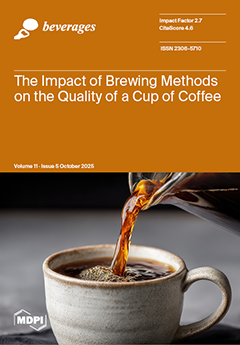Discovering new yeast species can be crucial for creating new types of beers. In this study, we investigated three new yeast species,
Saccharomyces bayanus,
Schizosaccharomyces japonicus and
Schizosaccharomyces pombe var. malidevorans, which have not been previously used in the brewing industry.
[...] Read more.
Discovering new yeast species can be crucial for creating new types of beers. In this study, we investigated three new yeast species,
Saccharomyces bayanus,
Schizosaccharomyces japonicus and
Schizosaccharomyces pombe var. malidevorans, which have not been previously used in the brewing industry. Colour, total acidity, bitterness, aroma profile, total phenolic, flavonoid, mineral content and organoleptic characteristics of beers fermented by these strains were analysed to discover their applicability in the brewing industry. They did not significantly affect the nutritional value and colour of the beers, but showed increased acidity compared to the control
Saccharomyces cerevisiae. GC-MS (Gas Chromatography-Mass Spectrometry) analysis revealed 33 aroma compounds, some of which were identical and some unique.
S. cerevisiae and
S. bayanus produced a similar number (19–20) of aroma compounds, while
S. japonicus produced the fewest, including some undesirable compounds. Isobutyl alcohol, isoamyl alcohol, acetol, dimethylpyrazine, acetic acid, 4-cyclopentene-1,3-dione, butyrolactone, 2-furanmethanol, phenylethyl alcohol, maltol and pyranone that provide desired aromas in beers could be found in every sample. The new yeasts significantly increased polyphenols and decreased flavonoid content. Based on the results above and the taste scores, the strains
S. bayanus and
S. pombe var. malidevorans may be suitable for brewing, while
S. japonicus is less or only suitable for combined fermentation.
Full article





